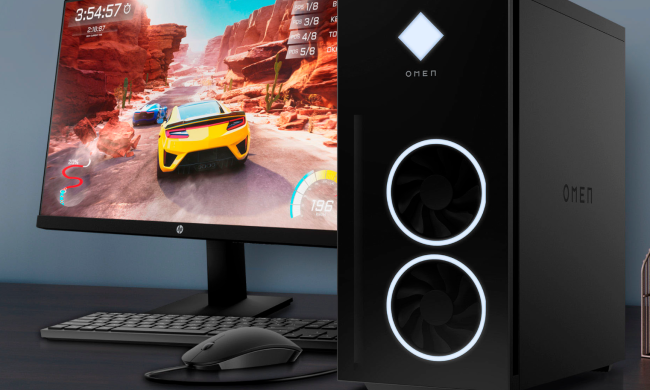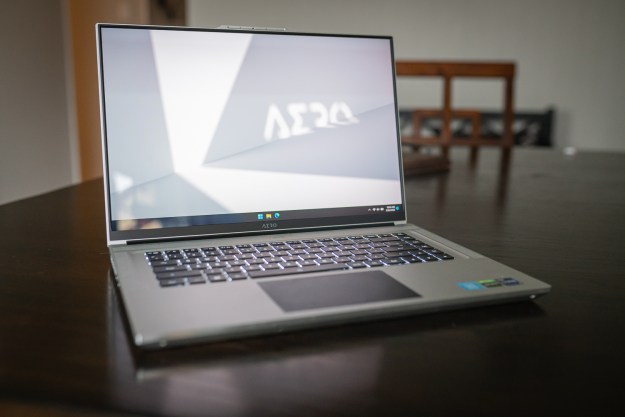
“Gigabyte's Aero 16 gets the hardware right, but it doesn't hold up to the competition.”
- Decent keyboard for typing
- Includes a USB hub in the box
- Beautiful OLED screen
- Solid gaming and CPU performance
- Poor battery life
- Screen is limited to 60Hz
- GPU is limited by power
Creator laptops are becoming increasingly popular, and why wouldn’t they? Take some components you would find in one of the best gaming laptops, put them in an aluminum body, add a few platform features, and you have a machine that can go against a MacBook Pro.
At least in theory.
The Gigabyte Aero 16 shows the weaknesses of this approach to design. Although it doesn’t do anything sorely wrong, it doesn’t do much right either. It’s a machine sold off a spec sheet, and it falls behind the best laptops despite the hardware packed inside.
Design

The design of the Aero 16 is a little off, but not in a bad way. This device, like most creator-focused laptops, takes a lot of cues from the MacBook Pro. It’s aluminum all around, but Gigabyte still subverts this tired design. There’s a small handle to open the machine, which is where the webcam lives, along with an Aero logo on the front that lights up when the machine is running.
It’s going for the look of a thin and light but not the feel. It has super-narrow bezels, but it’s a sizable 0.88 inches thick — and it clocks in at just over five pounds. It’s lighter than Dell’s XPS 17 by a hair, but the Aero 16 is still thicker. It’s in a middle ground between workstations focused on mobility like the XPS 17 and full-on gaming notebooks like the Lenovo Legion 5 Pro.
The Aero 16 is a tank.
In terms of build quality, the Aero 16 is a tank. I couldn’t produce any flex on the keyboard, and the slight amount of flex I found from the display required more force than I’m comfortable with. This is an expensive laptop, and it feels like one.
It doesn’t always look like one. The lip on top of the screen is a sore spot, especially considering it exposes the webcam when the lid is closed. I’m not a fan of the stark black-on-silver contrast with the keyboard and trackpad either — the keyboard looks great, but the trackpad makes the inside look like the designer was too eager with the paint bucket tool.
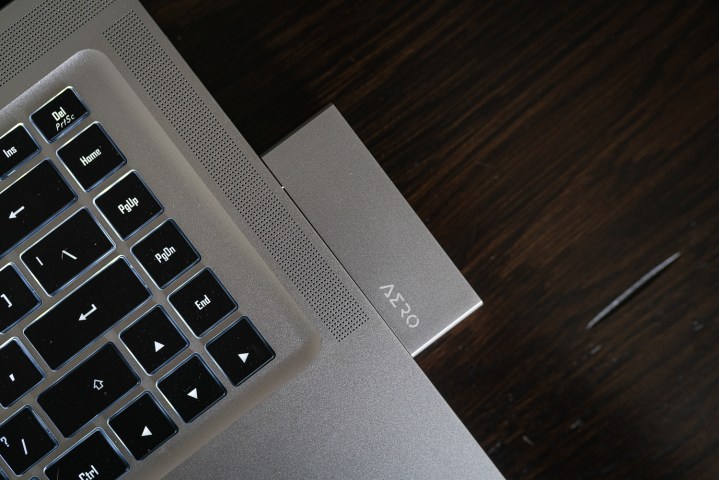
Around the sides of the machine, you’ll find three USB-C ports, two of which support Thunderbolt 4, and one among that pair that supports 100 watts of power delivery. Slim port selection isn’t a good look on a creator’s notebook, so Gigabyte generously includes a small hub in the box that includes a USB-A connection, an Ethernet jack, mini DisplayPort, and full-size HDMI.
I love the inclusion of this breakout box, just not the box itself. It feels cheap, and it loosely hangs on by the USB-C connection. An inopportune swipe would break it. That’s not to mention the fact that you could install it the wrong way, blocking the much-needed vents on the side. Still, it’s a plus that the hub is here, and Gigabyte even includes a small USB-C cable so you can hook it up properly.
Performance

The star of the Aero 16 is the unlocked Intel Core i9-12900HK processor. It comes with 14 cores and 20 threads, and it can boost up to 5GHz — a massive speed for any laptop. We’ve only had the chance to test this chip in one other laptop, the MSI GE76 Raider, and the version in the Aero 16 holds up.
| Gigabyte Aero 16 (Core i9-12900HK) | MSI GE76 Raider (Core i9-12900HK) | Lenovo IdeaPad Slim 7 Pro (Ryzen 7 5800H) | MacBook Pro (M1 Pro) | |
| Cinebench R23 | 1,907 / 12,969 | 1,872 / 16,388 | 1,419 / 11,262 | 1,531 / 12,343 |
| Geekbench 5 | 1,915 / 13,482 | 1,855 / 13,428 | 1,415 / 7,506 | 1,773 / 12,605 |
| Handbrake (lower is better) | 73 seconds | 72 seconds | 112 seconds | 95 seconds |
| Pugetbench for Premiere Pro | 1,115 | 1,120 | 496 | 977 |
| PCMark 10 | 7,864 | 7,691 | 5,943 | N/A |
Compared to the Raider GE76, the Aero 16 put up almost identical performance across the benchmarks I ran. The only exception was Cinebench’s multi-core test, which pushes the CPU to its absolute limits. You can see the Aero 16 give out before the Raider GE76, showing its power constraints due to the form factor.
When put up against AMD, Intel is massively ahead. The Lenovo IdeaPad Slim 7 Pro doesn’t have the flagship Ryzen 5000 mobile CPU, but it’s so far behind the Aero 16 that it hardly matters. AMD’s Ryzen 6000 mobile CPUs are almost here, however, which could put Team Red back on top.
The GPU in the Aero 16 lags behind dedicated gaming machines.
What stands out here, though, is the MacBook Pro with the M1 Pro. It’s nearly $2,000 cheaper than the Aero 16 I reviewed, and the M1 Pro is damn close considering that price difference. The M1 Max version is still nearly $1,000 cheaper, and it blows everything else away. If you’re focused on raw processor performance, Apple looks really attractive right now.
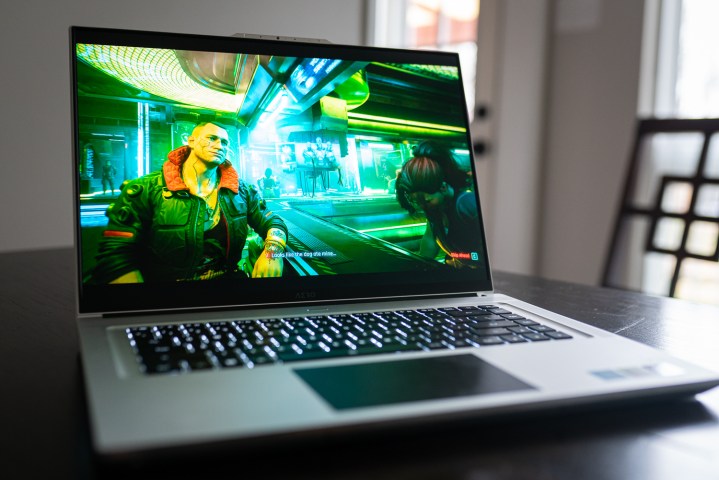
Graphics are a different story. You can’t get a discrete RTX 3080 Ti in the MacBook Pro like you can in the Aero 16. The Aero 16 is an Nvidia Studio laptop, so instead of the GeForce drivers that you’d find on gaming laptops, it updates with Nvidia Studio drivers targeted at creative applications.
| Gigabyte Aero 16 (RTX 3080 Ti) | MSI GE76 Raider (RTX 3080 Ti) | HP ZBook Studio G8 (RTX 3070) | |
| 3DMark Fire Strike | 21,141 | 28,220 | 17,729 |
| 3DMark Time Spy | 9,833 | 12,421 | 7,391 |
| Civilization VI | 217 fps | 192 fps | 163 fps |
| Cyberpunk 2077 | 52 fps | N/A | N/A |
| Cyberpunk 2077 – RT, DLSS | 50 fps | N/A | N/A |
That doesn’t mean you can’t game. I ran the Aero 16 through a few titles at 1200p — it has a 4K display, but 4K really isn’t an option — and it held up. Fifty frames per second (fps) in a demanding title like Cyberpunk 2077 is nothing to sneeze at, especially bolstered by ray tracing and Nvidia Deep Learning Super Sampling (DLSS).
But why is the Aero 16 so far behind the Raider GE76? They have identical specs, but the Aero 16 is closer to the RTX 3070 in the HP ZBook Studio G8. That’s because Nvidia lets laptop designers choose how much power the graphics card gets, and the Aero 16 is tuned lower than the Raider GE76.
MSI’s laptop can draw up to 175W, and with some special tech, even push that to 220W in some cases. The Aero 16’s RTX 3080 Ti tops out at 105W. It’s a thinner and lighter machine, and they comes out in performance with the GPU lagging behind dedicated gaming machines.
Display

The Aero 16 joins a small but growing list of laptops that come with VESA’s DisplayHDR 500 True Black certification, alongside machines like the Asus ZenBook 14X OLED. That’s the magic word: OLED. The Aero 16 comes with an OLED display capable of true black levels, and it’s astonishingly bright and dynamic.
It’s a 16:10 display with a resolution of 3,840 x 2,400, and Gigabyte says it covers 100% of the professional DCI-P3 color space. My color meter only picked up 73% of DCI-P3, however. Even more strange, the display comes factory calibrated from Gigabyte, but the calibration threw the colors way off in my initial testing. After I went back to the default color option — Gigabyte includes a profile that’s enabled by default — the display achieved a Delta-E value of 1.5, which is suitable for color work.
Still, I love how this display looks. At peak brightness, my color meter measured contrast of 788,400:1, and brightness above 600 nits. Even an excellent OLED display like the one on the Asus Vivobook Pro 16X OLED doesn’t reach those heights.
Watching movies, playing games — everything looked fantastic on the Aero 16. I pulled up a few LG OLED demos, and I was nearly salivating over how good they looked. Gigabyte also offers a mini LED display option, which comes with a lower resolution but much higher refresh rate. That might be a fine option if you want to play games on the Aero 16, but the OLED option is king when it comes to image quality.
Refresh rate is an issue, though. This panel is locked to 60Hz. Machines like the Lenovo IdeaPad Slim 7 Carbon are pushing ahead with 90Hz OLED displays, and I was missing that extra smoothness on the Aero 16.
Keyboard and touchpad

The keyboard and touchpad on the Aero 16 are solid, even if they aren’t impressive. The keys have a surprising amount of travel distance, as they seem to hover above the body by just a hair. I love long travel on a laptop keyboard, but the Aero 16 has a hollow, almost spongy feel. I never had issues with typing, and I’m satisfied with the quality, but I’m partial to keyboards on Dell’s XPS range, and even the keyboard on the Razer Blade 15.
The trackpad is nothing exciting. It supports Windows Precision drivers, so I was able to get through websites and various windows with gestures. It does the job well, but the Aero 16’s trackpad isn’t in the same league as the luxuriously large one on the MacBook Pro.
Battery life
The Aero 16 has bad battery life. Frankly, this is a machine you want to leave plugged in for any serious work, only freeing it from the charger for brief, undemanding work.
The Aero 16 comes with a 99 watt-hour battery, the largest size you can carry on a plane. It still falls behind machines rocking identical hardware, though. The Raider GE76, our main point of comparison for 12th-gen Intel chips, lasted about 6% longer in our web-browsing test. The Aero 16 lasted just three hours and 11 minutes.
In our local video playback test, the Aero 16 lasted four hours and one minute, far behind the competition. If you’re worried about battery life, Apple is the way to go right now. In this test, the MacBook Pro with an M1 Pro lasted an astounding 23 hours.
Camera and security

The Aero 16 is focused on performance, so it doesn’t come with the extra webcam goodies you find on productivity-focused machines like the HP Spectre x360. You get a 720p webcam with two microphones that attempt to cancel out background noise, as well as an infrared sensor for Windows Hello.
This is a last resort webcam. It looks terribly noisy even under decent lighting conditions, and lowlight shots make the camera look like it’s an even lower resolution than 720p. There isn’t a privacy shield, either, which feels like a missed opportunity considering the webcam lives in its own place on top of the display.
The audio quality from the microphones is equally as disappointing. They attempt to cancel out background noise, but end up making voices sound like they’re underwater. Worse, the microphones picked up the noise of the fans. Mind you, this isn’t fan noise, but the sound fans make from actually spinning.
This is a last resort webcam.
You’ll want a separate webcam, or at least a pair of earbuds, if you plan on attending meetings on the Aero 16. Gigabyte thankfully includes a meeting mode in the bundled software, which limits the fan speed for less noise.
On the security front, you have the option for Windows Hello, and the machine includes firmware TPM to meet Windows 11’s system requirements. Unfortunately, there isn’t a fingerprint reader here, and there aren’t any options for webcam security beyond putting a piece of tape over it.
Pricing and configurations
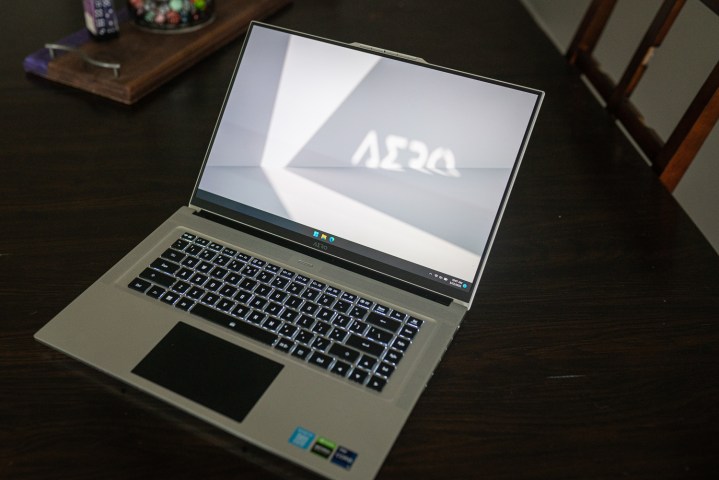
I’m reviewing the Gigabyte Aero 16 YE5, which is the flagship model that clocks in at $4,400. It’s the only model with the unlocked Core i9-12900HK, while five of the other six models use the Core i7-12700H. In core components, the major difference otherwise comes down to the graphics card, with the cheapest model going from an RTX 3080 Ti down to an RTX 3060.
You should pay close attention to which model you pick outside of the processor and graphics card. Only the top three models (YE5, XE5, and KE5) come with DDR5 memory support, while the others are limited to DDR4.
The cheapest model I could find in the U.S. clocked in at $2,350 (the XE4 model, in case you were wondering, which is the second-to-lowest in the range). That’s not a bad price considering MSI’s Creator Z16P clocks in at $3,000. That said, proper gaming laptops like the MSI Raider GE76 can reach below the $2,000 mark while offering the same specs.
Like a lot of 12th-gen machines, Gigabyte is putting a premium of DDR5. This laptop meets a midrange price with certain configurations, but you’ll need to jump into the high-end to unlock DDR5, even if you configure the machine with powerful specs otherwise.
Our take
The Gigabyte Aero 16 packs powerful hardware, but it’s not an ideal creator laptop. Poor battery life, a weakened GPU compared to gaming laptops, and a lack of quality-of-life features makes it tough for the Aero 16 to justify its asking price. Creators are better off with an efficient, and cheaper, machine like the MacBook Pro, while gamers are better off with a proper gaming laptop.
Are there any alternatives?
Yes, several:
- $3,499 MacBook Pro M1 Max — Not suited for gaming, but much better battery life, CPU performance, and build quality.
- $5,000 MSI GE76 Raider — A great alternative if you want to game on your laptop, and it performs better than the Aero 16. However, it’s more expensive.
- $1,600 Asus Vivobook Pro 16X — A great machine for creators if you don’t need the GPU power of the Aero 16 — and it comes with an OLED screen.
How long will it last?
The hardware inside the Aero 16 is powerful enough to last the next five years.
Should you buy it?
No. The Gigabyte Aero 16 doesn’t do anything egregious, but the competition is too stiff to justify a laptop that has a slew of minor issues.



